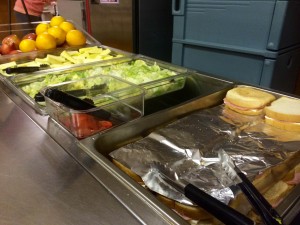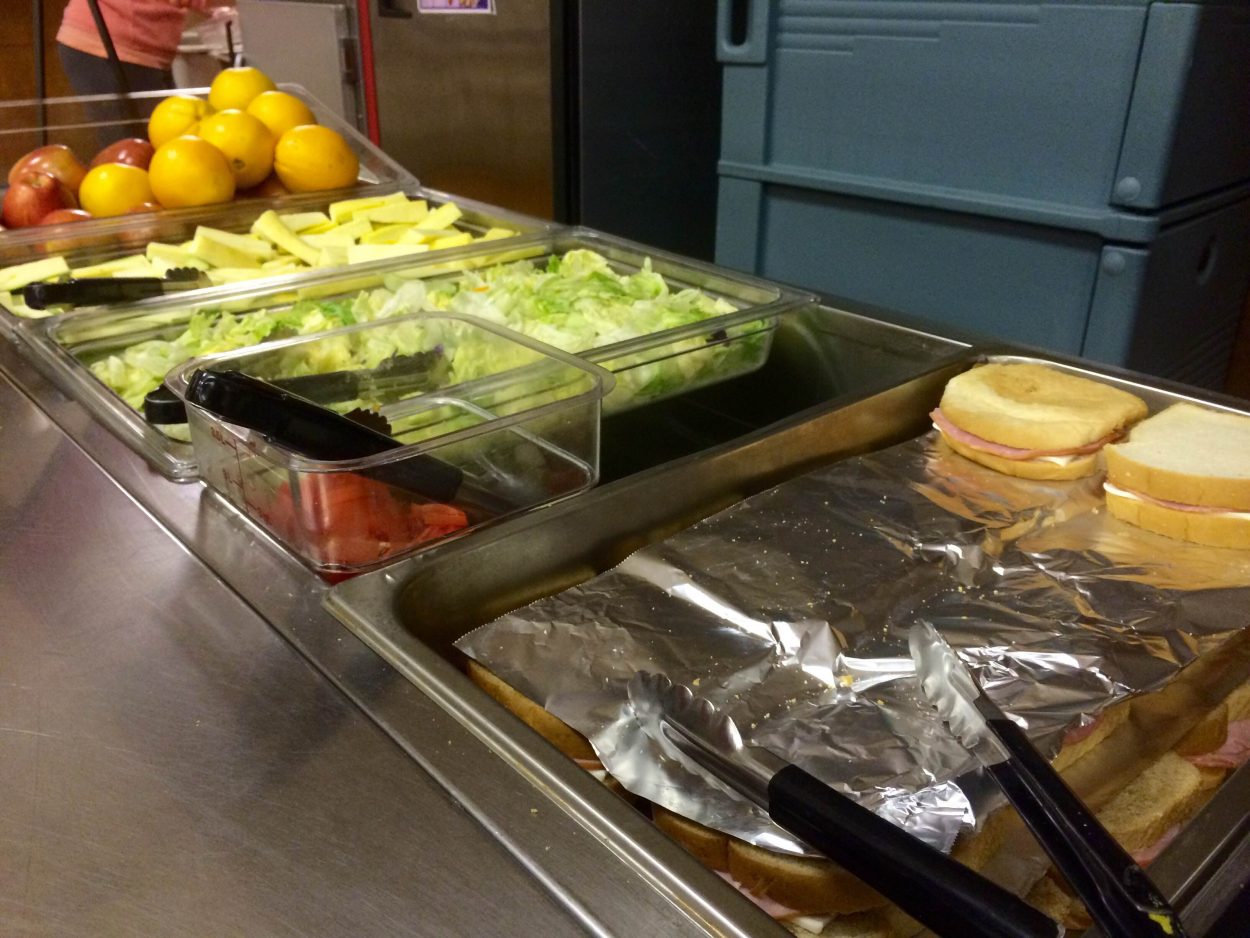
Students can serve themselves from the lunch counter at Evergreen Elementary School. (Katarina Sostaric/KSTK)
In response to budget cuts at the state level, the Wrangell Public School District left the National School Lunch Program earlier this year and replaced it with a cheaper, simpler “supplemental” food program. The new lunch program seems to be working, but it’s saving far less money than expected, and fewer students are buying lunches.
Third-grader Elizabeth Kissinger was eating lunch at Evergreen Elementary School. On her plate, she had a ham and cheese sandwich on white bread, salad, raw zucchini and squash, and an orange.
She said school lunch has changed a lot since last year, and one difference is that there’s less variety.
“Last year’s they had like a surprise like every day, but now it’s not really a surprise because every day is a sandwich,” Kissinger said.
But she still likes her lunches.
“It’s really cool. You can make stuff out of it,” Kissinger said. “They had zucchini and lettuce, so I made a salad.”
Wrangell students are noticing differences in their lunches because the district dropped its full-scale lunch program in exchange for a “supplemental” food program. Instead of a hot lunch, students receive a sandwich with raw fruit and vegetables, at the same price.
Last spring, the school board did not know how much money it would get from the state, so it came close to scrapping the entire food program.
It left the National School Lunch Program, which typically reimburses the Wrangell district for about half of its food program cost. The school board also canceled its contract with NANA Management Services, which had two employees working about 20 hours per week to prepare hot meals.
But then the district created a new lunch program by reassigning one existing school district employee to spend two hours a day preparing food.
“I prepare 80 meals a day. So it’s about 60 at the elementary and 15 to 20 over here at the high school and middle school,” said Leeann Martin, accounting clerk and food production manager. “Sandwiches, wraps, and I started doing egg salad with crackers, which they love.”
Martin said she wants to start making soup for the students, too.
“I think it’s going good,” Martin said. “We have a lot less throwaway. And the kids are able to choose what they want to take instead of us forcing them to have everything. They’re eating more because they get to choose what they take.”
School board members and parents were skeptical that one person could provide food for the students while working just two hours a day. Martin said she is working within that timeframe and staying within budget.
When the supplemental school lunch plan was proposed, school officials said it would save the district $60,000 to $70,000 a year.
But district Business Manager Pam Roope said savings will be about a third of that. She said food costs are under budget for now, but that could change.
The budget for this year’s supplemental food program is close to $58,000. And the budget for last year’s lunch program was three times that. But federal reimbursements brought the actual cost to the district down to about $77,000 for last year. That means the new lunch program will likely save the district around $20,000 compared to last year’s program.
Roope said she thinks the program is working, and it’s getting mixed reviews.
Fifth-grader Jonni Larsson said she ate school lunches last year, too. And she compared this year’s lunch to last year’s.
“I don’t really like it as much, but it’s fine,” Larsson said.
“There are a lot more vegetables,” fourth-grader Sean McDonald said. “And we can serve ourselves.”
McDonald said this lunch is very different from last year’s.
“Now there’s no milk for some reason,” he said.
Some students said they bring lunch because they don’t like the lunches that the school provides.
This year, participation in the school food program is about half of what it was in the first two months of last year, according to Roope. School lunch consumption has been decreasing in Wrangell since 2012.










